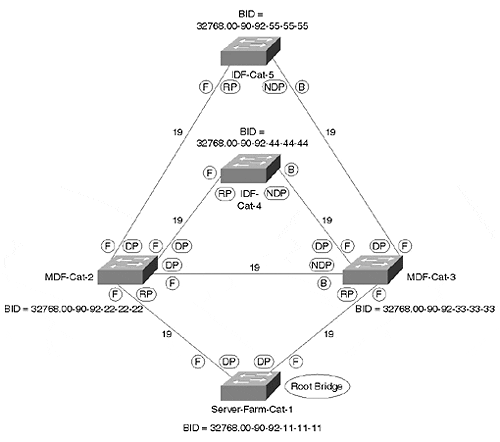Answers to Chapter 6 Review Questions
1:
Summarize the three-step process that STP uses to initially converge on an active topology.
A:The three-step process is as follows:
-
Elect a single Root Bridge for the entire bridged network.
-
Elect one Root Port for every non-Root Bridge.
-
Elect one Designated Port for every segment.
How many of the following items does the network shown in Figure 6-24 contain: Root Bridges, Root Ports, Designated Ports? Assume all devices are operational.
A:The network in Figure 6-24 contains the following: One Root Bridge, three Root Ports, and 404 Designated Ports (one per segment, including the 400 segments connected to end users).
3:When running the Spanning-Tree Protocol, every bridge port saves a copy of the best information it has heard. How do bridges decide what constitutes the best information?
A:Bridges use a four-step decision sequence:
-
Lowest Root BID
-
Lowest Path Cost to Root Bridge
-
Lowest Sender BID
-
Lowest Port ID
The bridge uses this decision sequence to compare all BPDUs received from other bridges as well as the BPDU that would be sent on that port. A copy of the best (lowest) BPDU is saved.
4:Why are Topology Change Notification BPDUs important? Describe the TCN process.
A:Topology Change Notification BPDUs play an important role in that they help bridges relearn MAC addresses more quickly after a change in the active STP topology. A bridge that detects a topology change sends a TCN BPDU out its Root Port. The Designated Port for this segment acknowledges the TCN BPDU with the TCA flag in the next Configuration BPDU it sends. This bridge also propagates the TCN BPDU out its Root Port. This process continues until the BPDU reaches the Root Bridge. The Root Bridge then sets the TC flag in all Configuration BPDUs sent for twice the Forward Delay period. As other bridges receive the TC flag, they shorten the bridge table aging period to Forward Delay seconds.
5:How are Root Path Cost values calculated?
A:Root Path Cost is the cumulative cost of the entire path to the Root Bridge. It is calculated by adding a port's Path Cost value to the BPDUs received on that port.
6:Assume that you install a new bridge and it contains the lowest BID in the network. Further assume that this devices is running experimental Beta code that contains a severe memory leak and, as a result, reboots every 10 minutes. What effect does this have on the network?
A:STP is a preemptive protocol that constantly seeks the Root Bridge with the lowest BID. Therefore, in this network, the new bridge wins the Root War, and the entire active topology converges on this bridge every ten minutes. Where links change state during this convergence process, temporary outages of 30 50 seconds occur. When the bridge fails several minutes later, the network converges on the next most attractive Root Bridge and creates another partial network outage for 30 50 seconds.
In short, the network experiences partial outages every time the new bridge restarts and fails.
7:When using the show spantree command, why might the timer values shown on the line that begins with Root Max Age differ from the values shown on the Bridge Max Age line?
A:The values shown in the Root Max Age line are the timer values advertised in the Configuration BPDUs sent by the current Root Bridge. All bridges adopt these values. On the other hand, every bridge shows its locally-configured values in the Bridge Max Age line.
8:Label the port types ( RP=Root Port, DP=Designated Port, NDP=non-Designated Port) and the STP states (F=Forwarding, B=Blocking) in Figure 6-25. The Bridge IDs are labeled. All links are Fast Ethernet.
A:Figure A-5 provides the solution for Question 8.
Figure A-5. Solution to Question 8.

Svr_Farm -Cat-1 becomes the Root Bridge because it has the lowest BID. MDF-Cat-2 and MDF-Cat-3 elect Root Ports based on the lowest Root Cost Path (19 versus 38). IDF-Cat-4 and IDF-Cat-5 have two equal-cost paths (38) to the Root Bridge. Therefore, to elect a Root Port, they have to use Sender BID as a tie breaker. Because MDF-Cat-2 has a lower Sender BID than MDF-Cat-3, both IDF Cats select the link connecting to MDF-Cat-2 as the Root Port. Designated Port elections are all based on Root Path Cost.
9:What happens to the network in Figure 6-26 if Cat-4 fails?
A:The network is partitioned into two halves. Each half elects its own Root Bridge. There is a partial outage of approximately 50 seconds. After the Root Bridges have been established, connectivity resumes within the two halves, but the two halves cannot communicate.
EAN: N/A
Pages: 223